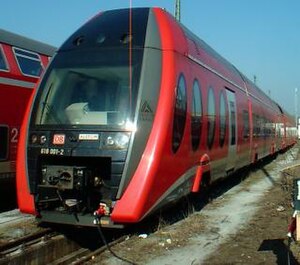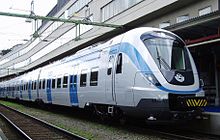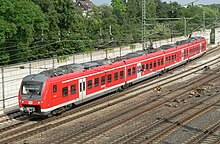Alstom Coradia LIREX
Alstom Coradia LIREX (abbreviation LIREX for lighter, innovative regional express ) is the product name of a family of modular, fully low-floor local transport articulated multiple units from the manufacturer Alstom Transport Germany, formerly Alstom LHB, Salzgitter, formerly Linke-Hofmann-Busch , wagon-vehicle machines GmbH.
The first vehicle in this family was the LireX DB series 618 running on radially adjusting single-axle bogies , which was originally intended to serve as a test vehicle for new technology in local transport. The aim of the development project funded by the state of Saxony-Anhalt , among others, was a modular multiple unit in lightweight construction that can be equipped with an electric, diesel-electric or hybrid drive.
A family of fully low-floor multiple units with conventional end bogies and Jakobs bogies between the intermediate cars has emerged from the concept through further development . The Coradia Nordic subfamily, suitable for operation in Nordic countries, was first developed and later the Coradia Continental subfamily was derived from it for operation in Central Europe. What all vehicles have in common is the arrangement of almost all components on the vehicle roof.
The vehicles are at least 95 percent recyclable .
DB class 618
| Alstom LHB Coradia LIREX DB class 618 |
|
|---|---|
|
DB 618 001/501
|
|
| Numbering: | 618 001 + 619 001 + 619 101 + 619 601 + 619 501 + 618 501 |
| Year of construction (s): | 2000 |
| Axis formula : | A'1'A'A '+ A'A'1'A' |
| Length: | 68,490 mm |
| Height: | 4500 mm |
| Width: | 3042 mm |
| Empty mass: | 160.0 t |
| Top speed: | 160 km / h |
| Hourly output : | 4 × 338 kW = 1352 kW |
| Brake: | KE-RA |
| Seats: | approx. 230-300 |
| Floor height: | 790 mm (passenger compartment) 550–760 mm (entrance area) |
| Particularities: | Flywheel storage: capacity 2 × 6 kWh = 12 kWh, corresponds to almost 32 seconds of full drive power |
The six-part multiple unit consists of two identical halves, each consisting of a two-axle intermediate car (M), on which the single-axle intermediate car (B) and the end car with driver's cab (A) are supported on both sides according to the drawbar principle. The cam-controlled single wheel running gear (KERF) used enables axleless wheel sets ("virtual axis"). Almost all of the drive technology is arranged on the car roofs. As a result of this, as well as the single-wheel chassis , a low-floor share of 100 percent could be achieved - the vehicle is completely barrier-free and can be crossed. The only 12 m long car units made it possible to achieve a large width (3.042 m); this means that five seats can be accommodated in a row without reducing the width of the aisle compared to conventional vehicles.
The train is driven by six water-cooled, converter-controlled three-phase asynchronous motors via two-stage gearboxes. The water-cooled traction motors, including the gears, are arranged directly on the single-wheel chassis. The service brake is electric.
The DC link of the converters is fed by four diesel generators. The generators used are particularly small and light machines with permanent magnets. The concept allows a diesel generator system to be replaced by a module with pantograph and transformer.
To improve the energy balance, the equipment was equipped with a flywheel storage device in order to be able to temporarily store energy released during braking. For the planned operation as an electric vehicle, braking current feedback would also have been possible.
To demonstrate future possibilities in local rail transport , this unique piece was equipped with various 'seating areas' and some entertainment electronics, comparable to the DB innovation train .
A planned deployment was initially to take place on the Thale – Quedlinburg – Magdeburg route , but then took place as a regional express between Magdeburg and Wittenberge . The first train even went as far as Ludwigslust to provide an ICE connection. After a year of use, the demonstration vehicle at the manufacturer Alstom LHB was to be converted from the diesel version to the electric version. A new type of traction power supply (“eTransformer”) based on power electronics , similar to a switched-mode power supply , should be used. However, this conversion did not take place. Since the end of June 2006, the vehicle in the DB component is z-made .
The train is currently in Delitzsch on the EuroMaint site . The DB AG prototype vehicle was added to the VDMT's list for sale against a bid on August 25, 2016 .
Coradia Nordic
The Coradia Nordic subfamily was derived from experience with the BR 618. The first series vehicle of the LIREX family was the six-part electric multiple unit X60 for AB Storstockholms Lokaltrafik (SL), of which 71 units have so far been delivered. The SL's X60s are 107.1 m long, six-part S-Bahn multiple units that run on seven two-axle bogies. They have 374 seats and 530 standing places. The other types X61 and X62 for regional traffic were later derived from the X60.
The vehicles are manufactured in Salzgitter . The suppliers include SMA (Niestetal) for the auxiliary converters, Faiveley Transport Leipzig (formerly HAGENUK - Hanseatische Apparatebaugesellschaft Neufeldt and Kuhnke) and MAB (machine and apparatus construction) (Schkeuditz) for the air conditioning in the passenger and driver's cabins and Faiveley Transport for the braking equipment , KNORR-Frensistemi (Florence) or BFG (Bahrain) for the toilets and Franz Kiel GmbH & Co. KG (Nördlingen) for the passenger seats.
Coradia Continental
The Coradia Continental were derived from the Coradia Nordic. These vehicles differ from the Coradia Nordic manufactured for Sweden by a new car body with straight side walls, adapted to the German boundary profile .
The front of the vehicles ordered so far is shorter because they are designed without crash absorption elements. At the customer's request, there are also no side cab doors, unlike in the Coradia Nordic.
The vehicles will be equipped with modular components adapted from the X60 according to the operating conditions in Germany. The air conditioning systems will have more cooling capacity and less heating capacity.
Orders were placed by DB Regio AG, BeNEX and NordWestBahn .
The first vehicles were to be used by DB Regio AG in the Augsburg E-Netz from December 2008 as Fugger Express. There were delays, so that the originally planned wing concept was not implemented until December 2009.
Since December 2010, further trains have been used by the NordWestBahn on the Regio-S-Bahn Bremen / Lower Saxony and by agilis in the Regensburger Stern network.
Class 1440 trains have been in service on the S5 / 8 line of the Rhein-Ruhr S-Bahn since December 2014 . These have new crash absorption elements.
From December 2015, new trains are to be used in the Lower Saxony East electrical network and in June 2016 in the Central Saxony II electrical network . These trains have side cab doors.
Since December 2019, trains of the 1440 series have also been used for the most part on the Breisgau S-Bahn .
Coradia Polyvalent
In autumn 2009, Alstom won the SNCF tender for a new generation of regional trains. The new trains, whose product name will be Coradia Polyvalent ( Régiolis ), will in turn be developed on the basis of the Coradia Nordic and Coradia Continental. The multiple units are manufactured in Alstom plants in France.
Three train configurations of 56 m, 72 m and 110 m in length have been announced.
literature
- LIREX - the light, innovative regional express . In: Eisenbahn-Revue International , Issue 11/2000, ISSN 1421-2811 , pp. 502–504.
- LIREX between innovation and modern train concept . In: Eisenbahn-Revue International , issue 10/2001, ISSN 1421-2811 , p. 458 f.
Individual evidence
- ↑ Brand new multiple units with a large number of seats . In: DB Welt , March 2008 edition, p. 14
- ↑ Search and offer list from October 12, 2016. (PDF) (No longer available online.) Archived from the original on September 23, 2016 ; Retrieved October 19, 2016 .
- ↑ en Alstom press release, October 27, 2009: SNCF awards Alstom a contract worth € 800 million for the supply of 100 Coradia Polyvalent regional trains



